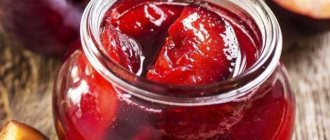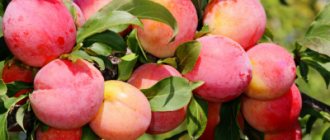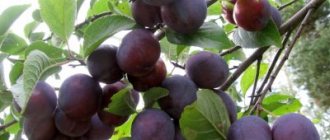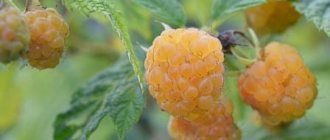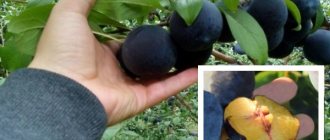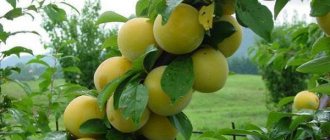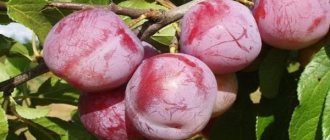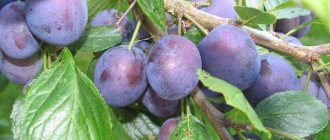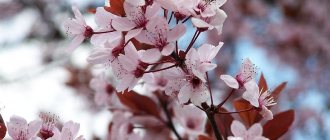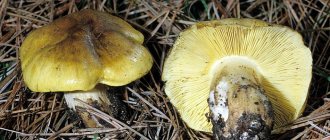Main Differences
Cherry plum varieties are divided into early-ripening, mid-ripening and late-ripening. By planting plants from different categories on the site, you can get sweet and tasty fruits from the end of June until frost. What else should you pay attention to? Some varieties are self-fertile and are grown singly; others need pollinators; to increase productivity, you will have to plant 2-3 more trees nearby. And one more thing - cherry plum varieties differ in the color of the fruits, which can be yellow, purple, or red.
Composition and calorie content
The chemical composition of cherry plum is incredibly diverse; it includes many components important for human health. Among them:
- vitamin and mineral complex (including vitamins A, B, C, E, PP, iron, potassium, magnesium and phosphorus);
- organic acids;
- fiber and pectin;
- tannins.
The fruits also contain a fairly decent amount of sugars of natural origin, although the calorie content of cherry plum is not at all high - only 34 calories per 100 g of product. Considering that this type of plum contains mainly fiber (a slowly digestible carbohydrate), it is quite acceptable to include the fruit in the diet even for people who are overweight and obese.
Early varieties
Variety July rose
The July Rose variety is one of the earliest, which is why in the southern regions of Russia it is called the June Rose. The variety was obtained in the 90s of the 20th century by crossing Chinese plums with Crimean cherry plum varieties. The result was a new species, characterized by good yield, frost resistance, and good fruit taste.
The tree is low, the crown is round, of medium density. The shoots are located horizontally, the trunk is even. The leaves are oval, large, with a pointed tip and serration.
The flowers are white, small, with wavy petals. Flowering occurs in April, fruits ripen at the end of June in warm regions, and at the beginning of July in areas with a cool or temperate climate. The fruits do not ripen at the same time; the harvest period extends for 2-3 weeks. They are oval, weighing about 30 grams, dark red in color, with a faint waxy coating. The pulp is yellowish, low-juicy, finely fibrous. The amount of sugar is 7%, acid is 2.3%, the aroma is weak.
The purpose of the fruits is universal; they can be consumed fresh, and for preservation and processing. The taste of the resulting products is estimated at 4-4.5 points.
Fruiting is early, from the third or fourth year from planting. Winter hardiness within -20-25 degrees, resistance to drought and hot weather at a high level. Resistance to characteristic diseases, including cluster blight, is at a high level.
Variety Found
The Naydena variety belongs to a group of hybrids with the common name Russian plum. Created in Russia in the last decade of the 20th century, as a result of cross-pollination of Chinese plum and cherry plum.
The variety is frost-resistant, suitable for growing in the Lower Volga, Chernozem and Central Chernozem regions of Russia.
A tree of medium height, with a flat-rounded and not very dense crown. The trunk is straight, the shoots grow horizontally. Young leaves stretch upward, but as they form and grow, they acquire a horizontal position. They are oval, large, wedge-shaped in shape.
Flower buds open in April and produce two small flowers, from which oval fruits weighing 27-30 grams are eventually formed.
The color of the skin is purple, with wax, the flesh is orange, fibrous in structure, not very juicy. Sugar content is low - 8.1%, slightly acidic - 1.69%.
The variety is early, fruiting begins in the middle or end of July and lasts for a whole month, ripe fruits do not crack, they are able to stay on the branches for about a week, during which time they become even softer and sweeter. But then they crumble.
Found to be a self-sterile variety that requires pollinators; without them there is no hope for a harvest. In a prosperous environment, being next to other varieties obtained from Chinese and Russian plums, you will be pleased with stable yields and tasty plums, suitable for consumption in processed or fresh form. Tasters give the products - preserves, compotes and jellies 4.3 - 4.4 points.
Types and common varieties
The main species obtained by crossing plum and apricot include:
- Plumcote or pluot is a hybrid of plum and apricot. Plumcat is a cross hybrid involving a hybrid plum. Pluot contains 25% of the hereditary information of apricot and 75% of plum.
- Aprium (“apricot plum”) - according to the description, it combines 75% of the properties of apricot and 25% of the properties of plum.
Also, when crossing apricot, plum and peach, sharafuga was obtained - a hybrid with the taste of plum and apricot. The hybrid of apricot and cherry plum is called black apricot, which combines several varieties:
- "Black Korenevsky" The fruits are purple and large. Needs regular fertilizing (potassium and phosphorus). Frost-resistant.
- "Black Kuban" The variety is early ripening. It has dark red fruits with a purple tint. Frost resistance is low compared to other varieties, but the immunity is strong.
- "Black Prince". It produces large fruits and has the highest yield among black apricots.
- "Black Melitopol". Apricots are dark red in color and ripen early. Possesses frost resistance. Unpretentious, but susceptible to moniliosis.
- "Alex" is an early ripening variety of plumcot.
- "Hummingbird" Mid-season variety. To obtain it, a hybrid of apricot and peach and plum were crossed. It produces large, sour-sweet fruits that ripen by the end of July. Frost-resistant, disease resistant.
- “Crown” is a mid-season variety.
- "Triumph" is a late variety.
- "Valentine." The hybrid is characterized by high productivity. The trees produce apricots that are orange or yellow in color and taste sweet, with a slightly noticeable sourness.
Mid-season varieties
Kuban comet
Kuban Comet is one of the typical mid-season varieties of domestic selection. It was bred on the basis of early-fruiting plum and Pionerka cherry plum back in the 20th century. The tree grows quickly at an early age, but after entering the fruiting season, 2-3 years after planting the seedling, growth slows down - all energy is spent on the formation of fruits.
It blooms at the end of April with small, white flowers. The fruits ripen at the end of July, they are large, weighing up to 35 grams, round or oval in shape. Their color is red, or dark purple, with wax. The pulp is dense, juicy, aromatic, yellow in color. The taste is wonderful, with apricot notes; tasters rate it 4.5 points. The fruits are consumed fresh or canned.
They do not crumble or crack for a long time, and withstand transportation well, maintaining their presentation and taste. Stores in the refrigerator for 2-3 weeks.
Winter hardiness is high - up to -25 degrees; in regions with cold winters, it is advisable to wrap the cherry plum and apply smoke on especially frosty days and nights.
The Kuban comet is partially self-fertile; a high harvest is possible only if there are pollinators nearby.
Apricot cherry plum
Apricot cherry plum forms large fruits of yellow-pink color, really reminiscent of apricots. The pulp is yellow-orange, juicy, with an apricot aroma, sweet with a pleasant slight sourness.
Fruit ripening occurs at the beginning or end of August, depending on climatic conditions. Russian gardeners are attracted by the variety due to its high frost resistance, within -30 degrees. But sharp transitions from frost to thaw, and then again to frost in winter, negatively affect the condition of fruit buds, as a result, the yield of the tree decreases.
The tree has an average height of 2.5 meters, reaches its maximum size by 5-6 years, but begins to bear fruit already from the second or third year of planting.
The fruiting period lasts for 2 weeks, during which time up to 60 kg of fruits are collected from one mature tree.
The fruits are tasty, rated 4.9-5 points by tasters, suitable for canning, making jams and preserves, as well as for fresh consumption.
Advantages and disadvantages
Apricot plum variety has the following advantages:
- the pulp of the fruit contains many nutrients;
- high frost resistance;
- large fruit;
- plums have a beautiful appearance.
The main disadvantage of this variety is the presence of an enzyme in the fruits, which can provoke the development of stomach ulcers. But only with frequent consumption of fruits on an empty stomach. Also, the fruits have low transportability and lose their attractiveness during storage. As you can see, this abrisliv is a very interesting variety that will be useful in your garden. Moreover, caring for it is not so difficult, and the fruits are very tasty.
Late varieties
Cherry Cherry Granite
Cherry plum Granite belongs to the group of mid-late and self-fertile plants. This is a hybrid obtained by Crimean breeders by cross-pollinating the Ashtarak cherry plum and the American plum Seedling Vaneta. Granite has been known to gardeners since 1986. The variety is suitable for cultivation in the North Caucasus and southern regions of Russia.
The trees are tall - up to 5-6 meters, the crown is not very lush, round in shape. The flowers are white, bloom in April, the fruits are oval-shaped, not large in size, their weight is about 25 grams.
The skin is burgundy or dark red, with a waxy coating, dense, and difficult to separate from the pulp. The pulp is rich yellow, juicy, tasty, sweet and sour.
Early fruiting is at an average level, fruits appear from 3-4 years, as a rule, ripen in late August or early September. An adult tree bears up to 80 kg of fruits, which are universally used. They are used fresh or processed.
The variety attracts with its frost resistance down to -30 degrees, resistance to drought, pests and diseases. Fruits damaged by the codling moth are very rare. Diseases also do not cause any harm to the tree.
Cherry plum: classification and best varieties
The waxy coating is average. The peduncle is of medium length.
The pulp is yellow, medium density, juicy, aromatic. The taste is good, harmonious, sweet and sour. The stone is medium-sized, semi-separable.
The variety is universal. Mid-late ripening. Productivity is high.
Winter hardiness is above average.
The Cherry plum variety 'Avalanche' is relatively resistant to disease.
Apricot plum is a hybrid variety of apricot and plum, obtained as a result of painstaking 30 years of work. The discovery of the variety belongs to the American breeder Floyd Zeiger. Unlike other fruit crops, the Apricot plum is characterized by high frost resistance, abundant and annual fruiting, excellent fruit taste, but requires pollinating trees.
Description of Apricot plum
Apricot plum has several subspecies:
Each variety is resistant to harsh winters. Their cultivation area extends to the northern and southern regions.
The trees of the hybrid are not tall - no more than 2.5 m. The crown is in many ways similar to a plum tree. Very often it has a drooping shape with medium-density foliage. The plant blooms with white flowers in early April. The fruits ripen by July-August.
Each variety of Apricot plum has common features in the description of the fruit:
- Large size. One fruit weighs from 30 to 70 g.
- Oval shaped plums.
- Green-pink, yellow or purple skin with a waxy coating.
- The fruit pulp is particularly juicy and dense.
Care
In order for the hybrid to develop normally and produce a harvest, it must be fed correctly and regularly. The features of feeding hybrid trees should be known to every gardener.
- In March, it is necessary to add ammonium nitrate to the soil. For 1 sq. m. it is enough to take 25 g of the substance.
- After the trees have finished flowering, they will need complex feeding. For this purpose, microfertilizers are purchased in stores. The most popular option is the drug "Kemira Universal". The complex of useful substances necessary for hybrid trees is produced in granules. The nutrient mixture is incorporated into the soil.
- In the fall, it is necessary to dig up the soil in the tree trunk circle. During the digging process, 2 buckets of compost are added under the trunk of each tree. Slurry is suitable as an autumn fertilizer.
In addition to feeding trees, you should pay attention to other activities.
- Annual pruning. The shoots growing inside the crown are cut off. Frozen and diseased branches must be removed. All manipulations are carried out in early spring. It is highly undesirable to carry out autumn pruning of hybrids.
- Watering. Drying out the soil can lead to the death of the plant. Plum nectarines do not need excess moisture. You cannot water seedlings when the weather is foggy outside.
- Loosening the soil.
Before the onset of winter, seedlings do not need to be covered with insulating materials. The hybrid of plum and peach tolerates frosts down to – 34 C without problems.
Characteristics of the variety
The characteristics of the Apricot plum variety affect the abundance of the harvest and the health of the hybrid. They must be taken into account when choosing a planting site, care procedures, and preventive measures.
Drought resistance, frost resistance
The variety is characterized by a high level of frost resistance. The hybrid can withstand significant temperature drops. It also tolerates warm climates and hot summers well.
Plum pollinators
Apricot hybrid is self-fertile. To improve the harvest, you can plant pollinators nearby - trees of similar varieties:
- Altanta;
- Renklod Kolkhozny;
- Plum Michurinskaya, others.
Productivity and fruiting
Apricot plum is a fast-growing hybrid. Fruiting occurs 2-3 years after planting. The yield increases as the variety matures. Blooms in April. Ripe fruits are picked in August-September. Up to 50 kg of fruits are collected from one tree.
Scope of drains
The sweet taste of plums makes them an excellent dessert. Jams, preserves, compotes, and juice are made from them.
Resistance to diseases and pests
The hybrid of plum and apricot is practically not susceptible to disease and is not affected by insects. It is necessary to carry out preventive measures to completely avoid harmful effects.
Advantages and disadvantages of the variety
Numerous advantages of the variety make the Apricot diploid hybrid popular among other garden crops:
- High level of frost resistance. This allows the variety to be planted in the northern regions.
- Precociousness. The plum bears its first harvest a couple of years after planting. The fruits ripen in mid-summer.
- Large fruits. The weight of one plum is up to 70 g. The taste is dessert. This makes the variety attractive for private and commercial gardening.
- Fruits are sources of many useful substances and vitamins.
Apricot plum has distinctive features:
- The pulp of the fruit contains a special enzyme. It provokes the development of stomach ulcers. You should not overuse plums on an empty stomach.
- Fruits do not retain their presentation during transportation.
- Plums cannot be stored for long periods of time. The picked ripe fruit must be consumed as soon as possible.
Specific characteristics
Hybrids are distinguished by their undeniable advantages: strong immunity, high productivity, and the ability to withstand severe frosts.
Advantages and disadvantages
The main advantages of hybrid varieties:
- frost resistance, which allows you to grow an apricot hybrid in areas with cold winters;
- delicious fruits rich in vitamins;
- disease resistance;
- unpretentiousness.
The sugar content in fruits is high - this is considered a disadvantage by people suffering from various diseases.
Photo: © nastol.com.ua
Features of the tree
Hybrid trees can grow 2–2.5 m in height - they are low fruit crops. The appearance of the leaves depends on the type of hybrid crop: aprium looks like an apricot tree, pluot looks like a plum tree.
Fruit quality and yield
Large oval fruits, the weight of some of them can reach 70 g. Apricot, crossed with plum, has a different color depending on the variety: purple, yellow, pink, burgundy, greenish.
Some fruits have an apricot flavor and are similar in appearance to plums. Others taste like plums. Inside is juicy and sweet fibrous pulp of yellow, purple or violet color, with a stone. The thin and smooth skin is slightly covered with a waxy coating. Sometimes there is slight pubescence on the surface. In everyday life, such hybrids are also called “purple apricots.”
In the first two years of life, hybrids do not bear fruit. But gradually the yield will increase - proper tree care also plays an important role in this. One mature tree can produce 30–40 kg of fruit. Fruits usually ripen by August. But you can also collect fruits that are not fully ripened - they are placed at home in a suitable place where they ripen.
Winter hardiness, disease resistance
Hybrid trees successfully tolerate severe frosts (up to 35°C), but react negatively to thaws in the winter months.
Thanks to their strong immunity, they are rarely attacked by pests and infectious diseases.
In the spring, before the trees bloom, you can carry out preventive spraying with fungicidal preparations (Bordeaux mixture is suitable).
Landing Features
Planting a plum hybrid is not a labor-intensive process. It is enough to choose the right place in the garden plot and follow the steps of planting a young seedling.
Recommended timing
Work with Apricot plum seedlings is carried out in early spring. Planting during this period ensures maximum rooting of the plant. Before the onset of cold weather, the young tree will have time to get stronger and get used to the local climate. In regions with mild, warm weather conditions, planting can be done in the fall.
Choosing a suitable location
Choosing a place for a hybrid seedling is a responsible task. It must meet certain criteria:
- Plentiful lighting throughout the day.
- No drafts or wind blown.
- The soil for planting must be nutritious and airtight.
What crops can and cannot be planted nearby?
Tall plants with spreading crowns should not be planted nearby. They will create additional shade for a short tree, which can affect the quality of the fruit. Similar varieties, apple trees, and evergreen shrubs will have a beneficial effect on planting.
Selection and preparation of planting material
The choice of planting materials should be approached responsibly and in advance. A set of gardening tools must include:
- A shovel for holes.
- Rake for loosening.
- Wooden stake, rope for fastening and fixing the seedling.
- Drainage.
- Fertilizers.
- Water for irrigation.
Landing algorithm
Planting the Apricot plum takes place in several stages. Each of them must be performed in accordance with the recommendations presented:
- Preparing the holes. Using a shovel, holes are formed. Depth – 80 cm, diameter – 80 cm.
- Drainage layer. A layer of brick and stone is laid out at the bottom of the planting hole.
- Feeding. After drainage, organic fertilizers, potash fertilizers, and superphosphate are poured into the pit.
- Planting a seedling. Its roots spread freely inside the hole. The cuttings are covered with earth, watered, and compacted.
- Additional reinforcement. The trunk of a young tree is tied with a soft rope to a wooden peg.
- An earthen roller is formed around the plum trunk. It will prevent the accumulation of liquid in the roots of the plant.
Landing rules
Hybrid seedlings must have enough time to take root and get stronger, so they are planted in early spring. Autumn planting is permissible only in areas with warm climates.
It is important to prepare the area for planting in advance. Trees are planted on flat or slightly elevated places, but not in lowlands
These fruit crops prefer good lighting, but are afraid of drafts.
The soil should be neutral, light, loose, without stagnant moisture. Lime is added to acidic soil (400 g per 1 m²). After planting a tree, liming should be carried out every 3 years. A layer of drainage (crushed stone, broken brick) is placed in a planting hole measuring 80x80 cm. Organic (2 buckets) and potassium (40 g) fertilizers are poured on top, superphosphate (60 g) is added. Fertilizers are covered with a 10–15 cm layer of soil. The seedling is placed in the hole and its roots are carefully covered with soil. Immediately after planting, water and tie up. If several trees are planted at once, maintain a distance of 3.5–4 m between them.
Aftercare for plums
When caring for the Apricot plum, it is necessary to take into account some nuances. They affect the health of the planting and a bountiful harvest:
- Watering. The hybrid does not like stagnant liquid. It is important to monitor the groundwater level. After each watering, the soil under the plant is thoroughly loosened.
- Formative pruning. To create a neat crown, the cutting of branches begins at the young tree.
- Feeding. It is carried out in three stages. Before flowering, nitrogen fertilizers are applied. Before fruit ripening, micro-feeding is carried out. In the fall, organic matter is added.
- Disease prevention. Regularly carry out preventive measures against diseases and pests. Cutting dry branches, destroying root shoots, and regularly cleaning the garden plot are mandatory procedures for maintaining plum immunity.
- Shelter for the winter. For a frost-resistant variety, it is enough to whiten the trunk with a solution of lime, cover the roots with pine needles and sawdust. In autumn, the soil under the plum tree is dug up.
Diseases and pests, control methods and prevention
Spots form on leaves, branches, and fruits. Subsequently they turn into holes. Leaves and fruits fall off. The branches are drying up
Before flowering, 2 weeks after it, the tree is treated with Bordeaux mixture. Affected areas must be completely destroyed
Red spots appear on the upper side of the leaf. The inside is covered with a white coating. Leaves fall, fruits dry up
Mandatory destruction of fallen leaves, branches, and fruits. The plum is sprayed with “Hom”, Bordeaux solution
The foliage turns brown and falls off. The tree doesn't bloom
As a preventive measure, you should get rid of the old bark. In case of massive pest infestation, the plum is treated with chemical insecticides
Features of cultivation
Due to the fact that this variety is a hybrid, in the first years after planting the seedlings and young plants require constant and complete care.
When the tree grows, care becomes easier and no longer requires as much attention. Planting of purchased healthy seedlings occurs in early spring. In this case, the plant will have enough time to take root well and become stronger. Autumn planting is allowed only in areas where the climate is mild and warm.
The area for this variety should be well lit and warmed by the sun during the day. At the same time, there should be no drafts on it. Nutritious and breathable soils are best suited for growing this species. If the soil is too acidic, a liming procedure is carried out before planting the seedling. 300–500 g of lime should be added per 1 m² of soil.
Plants are planted in planting holes with dimensions of 80x80 cm. A drainage layer of broken bricks and stones is necessarily formed at the bottom of the hole. 2 buckets of organic fertilizer are poured on top of the drainage. You also need to add 30–40 g of potassium fertilizer and 60–70 g of superphosphate.
When planting, the root system of seedlings should be free. It is covered with soil on top and watered well. This is done so that the soil better covers the roots. After planting is completed, the young tree must be fixed with additional support.
When caring for such a plum, it is important that the water does not stagnate in the circle around the trunk. In summer, when the weather is hot, after watering, it is recommended to mulch the soil with humus. Also, after each watering it is necessary to loosen the soil. In the autumn, trees must be dug up to prepare plants for winter.
When plantings are young, formative pruning is carried out. Thanks to it, a correct crown is formed, from the branches of which it is easy and convenient to remove the ripe crop. The hybrid needs to be fed several times throughout the year: in early spring (nitrogen fertilizers), after flowering (micro-fertilizing), in autumn (organic fertilizers).
Apricot plum: variety description
The diploid early-fruiting Apricot plum is valued for its tasty and aromatic fruits. They are very sweet and juicy.
Mature tree height
Apricot plum reaches a height of 2.5 meters, so the fruits can be collected from a stepladder. The crown shape is round-spreading or fan-shaped. The shoots are red-brown, slightly pubescent. The buds are small. The medium-sized, light green foliage has an elongated, obovate shape, with prominent serrations along the edge of the leaf.
The leaves are smooth, wavy, and sit on small petioles. White flowers are collected in a three-flowered inflorescence.
Flowering and ripening period
In April, the bouquet branches are completely covered with snow-white flowers. Fruit ripening is uniform; in 10 days, up to 50 kg of plums can be harvested from one fruiting tree. The ripening period is in August.
The fruits are oval, oblong, slightly velvety skin colored yellow-orange. A waxy coating is barely noticeable on plums. The pulp is characterized by high taste and juiciness.
Drought resistance
The fruit tree can tolerate mild drought, but during fruit set and ripening it needs abundant watering.
Frost resistance
Frost resistance is an important characteristic of the Apricot plum variety. The tree easily tolerates frosty winters even at a time when the thermometer drops below -30ºC. But the variety does not like prolonged thaws.
Description of april
This hybrid is a selection product of crossing well-known fruit crops, consisting of 25% plums and 75% apricots. This extraordinary and interesting type of fruit trees can be divided into the following subspecies:
- Pluot. A variety with a predominance of up to 75% of the plum trait, but only 25% includes apricot traits.
- Plumcat. This hybrid crosses an apricot and a hybrid plum.
- Aprium. This is an apricot crossed with a plum, a hybrid variety with a predominance of up to 75% of apricot characteristics and only 25% containing the properties of a plum.
Regardless of the name, all varieties of april are united by one important property - these trees are characterized by high frost resistance. Amateur gardeners who already have experience in growing a hybrid of plum and apricot note that the hybrid has a good wintering even in severe frosts, up to 30 degrees
The only drawback is that during the wintering period the fruit breed does not tolerate sudden thaws well.
Amateur gardeners who already have experience in growing a hybrid of plum and apricot note that the hybrid survives a good winter even in severe frosts, up to 30 degrees. The only drawback is that during the wintering period the fruit breed does not tolerate sudden thaws well.
The apricot plum hybrid has the following description:
- The height of the tree is up to 2.5 meters. The appearance of the leaves and crown corresponds to the biological qualities of their “ancestors”. So, Pluot looks more like a plum, and Aprium looks like an apricot tree.
- The crown is drooping, similar to a weeping willow.
- Flowering begins in April.
- Fruiting occurs within two or three years from the start of planting. At first, a small number of fruits ripen on the trees, but over time, harvest activity increases. The ripeness phase begins in late July or early August.
- The fruits are oval-shaped and weigh from 30 to 70 grams.
- The color of the peel is directly related to the varietal characteristics of the breed and can be greenish-pink, yellow and purple. The skin of the fruit is covered with a slight waxy coating.
- The skin of the fruit is smooth, without the velvety coating characteristic of apricots.
- The pit is similar in appearance to an apricot. The Plumcot variety is characterized by poor separation of the pit from the pulp, while the Aprium abros plum, on the contrary, separates well.
- The pulp has a fibrous structure, dense and very juicy. The color depends on the “native” varietal characteristics of the hybrid.
- The appearance of the fruit is similar to that of a plum.
- Taste. Abros plum fruits have an apricot flavor with a faint orange aftertaste. Sometimes, for various reasons, gardeners have to pick unripe fruits; at home, they ripen well.
Jam from plum hybrid culture
In the first years after planting, young seedlings need complete and proper care. If you follow all the rules for growing a hybrid, you can achieve high yields and get up to 50 kg of tasty fruits from one tree.
Fruits are eaten fresh, processed into preserves, jams, compotes and used for home winemaking. Fruit juice made from these fruits is especially tasty.
How to plant Apricot plum
For good growth, development and abundant fruiting of the Apricot plum, it is recommended to follow agrotechnical cultivation methods.
How to choose a seedling
The appearance of the plum seedling should be fresh, healthy, without signs of rot or drying out.
An important characteristic feature when choosing a seedling is its growth. For annual trees, the optimal height is 1-1.3 meters. If the seedling is significantly lower, it means that it has not been properly cared for or has already become ill.
Planting dates and scheme
Apricot plum seedlings are recommended to be planted in a permanent place in the spring. Planting carried out during this period guarantees better rooting of fruit trees. If you plan to plant several seedlings, you must maintain a distance between plantings. The optimal distance is 2.5-3 meters.
Site selection
When choosing a place to plant a hybrid variety, it is recommended to follow the following rules:
- the area should be well lit;
- seedlings are planted in breathable, nutritious soil;
- The place should be protected from gusty winds.
Apricot plum does not tolerate high soil acidity, so it is recommended to lime the soil before planting.
Pit preparation
Tree planting is carried out in accordance with the sequence of actions. First you need to dig a hole with a depth and diameter of 80 cm.
A drainage layer of broken brick or expanded clay must be laid at the bottom. Then mineral and organic fertilizers are added to the soil and the lower part of the hole is filled with it.
After installing the seedling, it is necessary to straighten the bark system, sprinkle it with soil, compact it and water it.
Then you need to make a roller of soil so that in dry times and during watering the water does not spread over the surface, but nourishes the root system of the plant.
Landing rules
For good growth and development, as well as for high yields, it is necessary to comply with agrotechnical growing conditions.
It is important to choose the right planting material, observe planting dates, organize watering and pruning in a timely manner, and carry out preventive measures to combat diseases and pests.
Recommended timing
Apricot plum seedlings are planted in early spring to ensure maximum rooting of the plant. Before the onset of cold weather, the young tree will have time to adapt to the climate regime of the region and become stronger. If you plan to plant several seedlings, you need to maintain an interval between plantings. The optimal distance is about 3 meters.
It is recommended to plant in the fall in regions with warm weather conditions.
Choosing a suitable location
The planting area should be protected from winds and drafts and well lit. Drained soil with a neutral reaction is suitable. If the acidity of the soil is high, before planting you need to evenly apply 400 g of lime per square meter.
What crops can and cannot be planted nearby?
Tall trees with a spreading crown should not be planted next to apricot plums, since blocking the sun's rays will have a bad effect on the quality and quantity of the harvest. Similar varieties, apple trees and evergreen shrubs have a beneficial effect on planting.
Selection and preparation of planting material
When choosing seedlings, you need to pay attention to their appearance. Planting material must be fresh, without signs of rot or drying out
It is best to buy a seedling with an open root system. The roots should be light, undamaged, without stains
An important characteristic of seedlings is growth. For annual trees, a height of 1-1.3 m is considered normal.
Saplings with shorter stature are not suitable for planting.
Before starting planting work, it is necessary to prepare a wooden stake, a rope for attaching and fixing the seedling, drainage, fertilizers and water for irrigation.
Landing algorithm
Compliance with the sequence and planting rules is a guarantee of normal growth and good fruiting of the tree. The landing algorithm is as follows:
- Preparing the hole. Using a shovel, create holes with a depth and diameter of 80 cm.
- Drainage. A layer of bricks and stones is distributed at the bottom of the planting pit.
- Feeding. Organic and potash fertilizers and superphosphate are poured onto the drainage layer.
- Planting. The roots inside the hole should expand freely. The cuttings are covered with soil, watered and compacted.
- Auxiliary strengthening. The trunk of the seedling is tied with a rope to a pre-prepared stake.
- A roll of soil is formed around the tree trunk to prevent the accumulation of liquid in the root part.
Apricot plum care
Caring for apricot plums in the Moscow region involves choosing the right location, timely moderate watering, fertilizing, and pruning. It is important to know how plum pollination occurs. It is these factors together that help to obtain a high yield.
Feeding and watering
When planting, it is important to choose a high, well-drained area, since the root system of the fruit tree does not tolerate stagnant water. After watering, it is recommended to loosen the soil in the tree trunk circle. You need to water abundantly. The soil should dry out completely between waterings.
During the season, plums are fed in 3 stages:
- Spring application of nitrogen-containing fertilizers is carried out directly into the soil in early spring, during flowering and after flowering. At the end of May, plums need organic matter: chicken droppings, urea, saltpeter.
- During the summer, foliar fertilizing with nitrogen-containing fertilizers is carried out by spraying fruit trees. Closer to autumn, it is recommended to add organic fertilizers to the soil.
- Autumn feeding consists of saturating the plantings with minerals. During this period, plums need phosphorus and potassium.
You can apply complex fertilizers, which are sold in specialized stores.
Trimming
To obtain a high yield, it is necessary to prune the plum tree in a timely manner. It can be formative or sanitary. The formation of the crown should be done in the first years after planting the seedling. Every year it is recommended to carry out sanitary pruning: remove diseased, dry shoots, as well as branches that interfere with the growth of other shoots.
Pollination of apricot plum
The photo description of the Vetraz plum variety indicates that it is a self-pollinating species. But the Apricot plum blossoms in April. During this period, there are no pollinating insects. To get a high yield, it is recommended to use hand pollination.
Apricot varieties are considered good honey plants and produce a lot of beebread. Thanks to this feature, fruit trees attract bees even in bad weather. Therefore, to ensure good productivity, you need to install hives in the garden in the amount of 5-6 bee families per 1 hectare of plantings.
In addition, it is important to plant varieties such as Traveler and Asaloda nearby.
Requirements for cultivation and care
A hybrid fruit tree reacts poorly to both drought and excessive soil moisture.
It is equally important to feed the tree in a timely manner. In the spring, as soon as the snow melts, add 30 g of ammonium nitrate per 1 m²
Perform the second mandatory feeding at the beginning of autumn: one plant requires 20 liters of diluted organic matter (humus).
Important! Carry out the next watering when the soil dries out - after moistening, do not forget to loosen the soil. Covering the ground with humus will help slow down the drying process in the hot summer. With the arrival of March, remove all dried branches from the tree: the purpose of spring pruning is the correct formation of the crown
Follow these simple recommendations, and you will get an excellent harvest of non-standard fruits in your garden with good taste and attractive appearance.
With the arrival of March, remove all dried branches from the tree: the purpose of spring pruning is the correct formation of the crown. Follow these simple recommendations, and you will get an excellent harvest of non-standard fruits with good taste and attractive appearance in your garden.
Diseases and pests of Apricot plum
Plum is affected by diseases that are inherent in all stone fruit crops: cherries, apricots, cherries, and peaches.
Apricot plum can develop black nodule, ovular spotting, and scab. The trunk and branches are affected by the false polypore and the red plum polypore, flat, sulfur-yellow.
On the leaves you can see a saprotrophic fungus, a multihost fungus. The plum suffers from a milky sheen and penicillium rot of the fruit. Timely inspection and detection of diseases will allow you to deal with them in time and prevent the death of fruit trees.
Pests include aphids, codling moths, and leaf rollers.
Harm and contraindications
The cherry plum itself does not pose a serious danger to the body of a healthy person, if, of course, it is consumed in moderation. The following points may be contraindications to including this fruit in the diet:
- a tendency to diarrhea and other digestive disorders. The fruits have a laxative effect;
- problems with the gastrointestinal tract: increased stomach acidity, gastritis, ulcers. Organic acids contained in fruits can irritate the tissues of the digestive tract, causing attacks of pain;
- "infant" age. It is not recommended to give cherry plum fruits to children under one year old, even in minimal quantities, to avoid intestinal upset and allergic reactions. From the second year of life, the fruit can be gradually introduced into the child’s diet, adding it to porridge or using it in the preparation of compotes.
Domestic plum fruits should not be eaten together with the seeds - they contain an extremely poisonous strong acid that can cause severe poisoning of the body.
